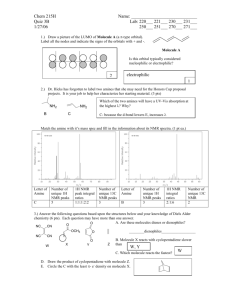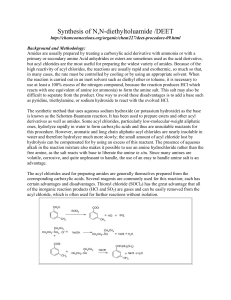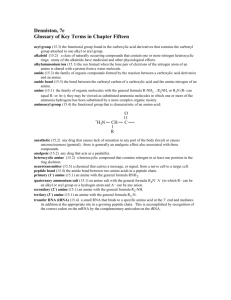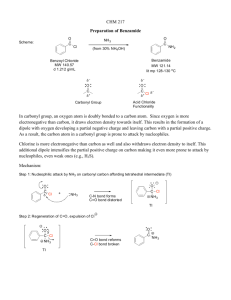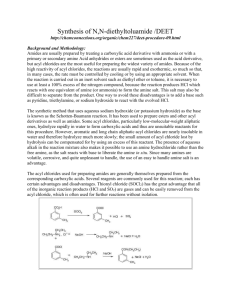Expt 5. Part 2. Preparation of DEET. VT NMR Study of Amide C
advertisement
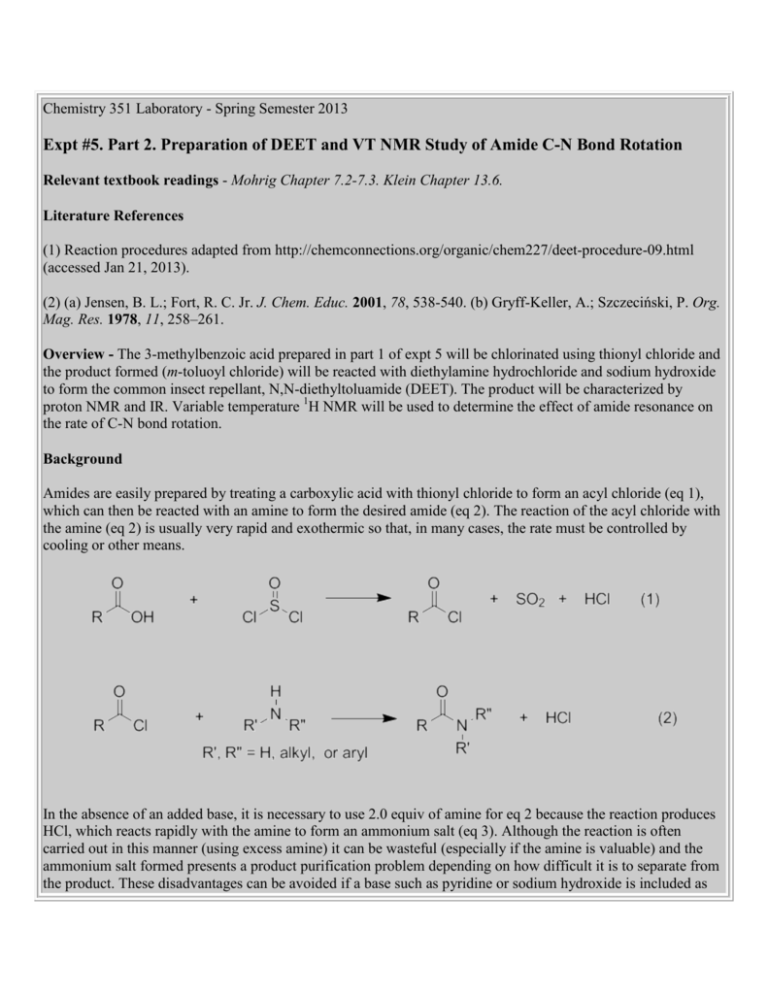
Chemistry 351 Laboratory - Spring Semester 2013 Expt #5. Part 2. Preparation of DEET and VT NMR Study of Amide C-N Bond Rotation Relevant textbook readings - Mohrig Chapter 7.2-7.3. Klein Chapter 13.6. Literature References (1) Reaction procedures adapted from http://chemconnections.org/organic/chem227/deet-procedure-09.html (accessed Jan 21, 2013). (2) (a) Jensen, B. L.; Fort, R. C. Jr. J. Chem. Educ. 2001, 78, 538-540. (b) Gryff-Keller, A.; Szczeciński, P. Org. Mag. Res. 1978, 11, 258–261. Overview - The 3-methylbenzoic acid prepared in part 1 of expt 5 will be chlorinated using thionyl chloride and the product formed (m-toluoyl chloride) will be reacted with diethylamine hydrochloride and sodium hydroxide to form the common insect repellant, N,N-diethyltoluamide (DEET). The product will be characterized by proton NMR and IR. Variable temperature 1H NMR will be used to determine the effect of amide resonance on the rate of C-N bond rotation. Background Amides are easily prepared by treating a carboxylic acid with thionyl chloride to form an acyl chloride (eq 1), which can then be reacted with an amine to form the desired amide (eq 2). The reaction of the acyl chloride with the amine (eq 2) is usually very rapid and exothermic so that, in many cases, the rate must be controlled by cooling or other means. In the absence of an added base, it is necessary to use 2.0 equiv of amine for eq 2 because the reaction produces HCl, which reacts rapidly with the amine to form an ammonium salt (eq 3). Although the reaction is often carried out in this manner (using excess amine) it can be wasteful (especially if the amine is valuable) and the ammonium salt formed presents a product purification problem depending on how difficult it is to separate from the product. These disadvantages can be avoided if a base such as pyridine or sodium hydroxide is included as an additional reactant. The Schotten-Baumann reaction is the variation of this reaction that uses aqueous sodium hydroxide as the base (eq 4). Water-soluble acyl chlorides are unsuitable reactants for this procedure because they will hydrolyze rapidly in water to form carboxylic acids (thus undoing eq 1). However, most aromatic acyl chlorides are practically insoluble in water and, therefore, hydrolyze much more slowly. The use of NaOH also makes it possible to use an amine hydrochloride rather than the free amine (e.g. Et2NH2+ Cl− instead of Et2NH) because the salt reacts with base to form the amine in situ. Many amines are corrosive and malodorous so the use of an amine salt is often advantageous. A disadvantage of the Schotten-Baumann reaction is that very efficient mixing is necessary to provide adequate contact between the water-insoluble acyl chloride and the amine. To overcome this we will use a detergent known as sodium lauryl sulfate. Detergent action helps disperse the acyl chloride into smaller particle sizes that increase the reaction rate. Procedures Preparation of m-Toluoyl Chloride Use dry glassware and wear gloves for these procedures! Thionyl chloride decomposes violently on contact with water to produce poisonous gases (HCl and SO2). Avoid skin contact with it, keep away from water, and do not breathe its vapors. Place 5 mmol m-toluic acid and 6 mmol thionyl chloride in a 4-mL conical vial (14/10 standard taper) equipped with a magnetic spin vane. Attach a condenser and gentlyrefluxwith stirringfor 30 minutes or until the evolution of gases stops. Check for HCl evolution using litmus paper inserted into the top of the reflux condenser. Cool the reaction mixture to ~10 oC on an ice bath. Stopper the vial and leave the m-toluoyl chloride in the hood until you are ready to use it in the next step. (Do not determine the yield of this product!) Reaction of m-Toluoyl Chloride with Diethylamine Hydrochloride Add 6.0 mL of 3.0 M NaOH(aq) to a 25 mL r.b. flask. Add a stir bar and cool the mixture on an ice bath. Carefully add 5 mmol of diethylamine hydrochloride. Add 0.1 g sodium lauryl sulfate. Attach a reflux condenser to the flask. Use a pipet to slowly add (through the top of the condenser) the cold m-toluoyl chloride from part A to the stirring NaOH/ Et2NH2+ Cl− solution . When the addition is complete, heat on a hot water bath for 15 min. Work-up Cool the reaction mixture to room temperature. Transfer it to a test tube and extract it with three 3-mL portions of dichloromethane. Wash the combined DCM extracts with 5 mL of 5% NaOH followed by 5 mL of water. Dry over sodium sulfate and then evaporate the solvent using the rotary evaporator. Determine the yield. Characterization. Obtain the proton NMR spectrum and, if you have enough material, also the IR spectrum. Variable Temperature (VT) NMR. One group will also be chosen to obtain the spectrum at varying temperatures. These spectra will be available to the whole class in the class storage folder. Background for VT NMR. We can use the VT NMR results to learn about amide resonance and specifically how it affects rotation of the amide C-N bond. The energy barrier to rotation about carbon-carbon single bonds is usually about 3-5 kcal/mol. This low barrier means that these bonds freely rotate. For instance, the C-C bond of ethane rotates approximately 1011 times per second at room temperature. However, rotation about the the C-N bond of an amide is much less "free". This is due to the amide resonance which makes the C-N bond have appreciable double bond character. In other words, rotating the C-N bond destroys the pi overlap between the carbonyl carbon and the nitrogen resulting in a much higher energy barrier (Ea) for bond rotation. The rate of a chemical reaction is related to the activation energy (Ea) according to the Arrhenius equation. k = A × e-Ea/RT A is the Arrhenius factor and is approximately 2 x 1013 for the reaction being considered here. R is the gas constant = 0.001987 kcal mol-1 K-1 and T is the temperature in Kelvins. Nuclear magnetic resonance occurs on a slow time scale. Therefore, fast reactions are not discernable by NMR and the observed spectrum is the average spectrum of the interconverting molecules. In general, an averaged spectrum is observed when the rate of the process is 2π times the frequency difference (2π × ∆ν) between the peaks being observed. For example, consider a hypothetical molecule with two nonequivalent methyl groups with 1H NMR chemical shifts of 1.0 and 1.5 ppm on a 300 MHz instrument. The frequency difference between the two peaks is 150 Hz (0.5 ppm x 300 Hz/ppm). If a chemical process interconverts these methyl groups significantly faster than 900 times per second (900 s-1) (2π × 150 Hz) (Hz = s-1) then these six protons would show up as a single peak at 1.25 ppm. In contrast, if the methyl groups interconvert much slower than 900 times per second then they will show up as two distinct peaks at 1.0 and 1.5 ppm. When the interconversion rate is about equal to 2π × ∆ν the six methyl protons will appear as a single broad peak at the average chemical shift (1.25 ppm). Increasing the temperature increases the rate of a reaction according to the Arrhenius equation (given above). Therefore, in certain cases it is possible to time a chemical process by finding the temperature at which averaged spectra for the interconverting groups are obtained. At lower temperatures the process is slower and separate peaks are observed. At higher temperatures, one sharp peak at the average chemical shift value is obtained. Thus, the rate and the Ea of C-N bond rotation in DEET can be determined by obtaining the proton NMR over a range of temperatures. VT NMR Data Interpretation. Use the VT spectra to determine the temperature at which the two ethyl groups of DEET start to become equivalent, i.e., when the Ha and Hb signals each coalesce to form one broad peak for each. At this temperature, the rate of bond rotation (k) is approximately 2π × ∆ν. Because the ∆ν values are different for Ha and Hb these peaks are not expected to coalesce at exactly the same temperature. (Use the lowest temperature spectrum to determine ∆ν values.) Hence, k at this T can be determined and A and R are known, so we can calculate Ea using the rearranged Arhennius equation: Ea = ln (A/k) x RT The value of Ea so obtained can be compared to literature values (reference 2).


